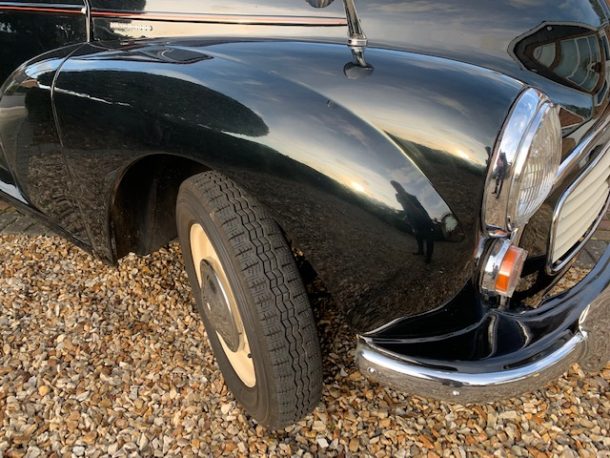Why a new set of tyres can transform your classic car

The search for classic car tyres is now easier than it once was, with many of the big brands offering suitable tyres. DAVID HOOPER looks at some of the considerations and the difference a set of premium Michelin covers made to Doris the Morris.
LOOK at the width of a Morris Minor’s tyre and you’ll probably be struck by how thin it is when compared to a modern car’s tyre which can nowadays often be easily two or three times as wide.
It doesn’t seem that long ago that serious concerns were being raised in the classic car community about the future availability of suitable tyres for our beloved classics, with many owners beginning to struggle to find suitable covers for their ageing wheels.
Although there’s a thriving classic car scene in Britain and elsewhere, the demand for tyres is comparatively small in relation to that for modern cars, so you can understand the manufacturers not wanting to produce tyres for what has become something of a niche market, and while there are lots of classic cars on our roads, they don’t tend to need new tyres very often.
Most owners of classic cars have other daily drivers, so the classics only come out when the sun’s shining and don’t tend to do that many miles, so a new set of tyres on a classic will last several years in normal use. In fact, the rubber may well harden and crack before the tread wears down to the minimum legal limit. Moves are afoot to ban tyres more than 10 years old on some vehicles for safety reasons, but at the time of writing, it is unclear whether this would apply to classic vehicles.
So my lovely old Morris Minor, Doris as she’s known to her friends, needed new tyres. The tyres she had were old and the rubber had cracked and were clearly no longer safe. As I began my search, I quickly realised that I was almost spoilt for choice – a pleasant surprise indeed, with tyres available from the mainstream manufacturers like Michelin, Pirelli and Bridgestone, as well as Nankang.
Having been on a few events with tyre manufacturers over the years, I have come to appreciate the black circles everyone takes for granted. The work that goes into creating them is a science in itself, with many tyres these days having different tread patterns to do different things on different parts of the same tyre. In fact, it’s not uncommon to have different rubber compounds on different parts of a tyre, too.
I opted for the premium Michelin X 155 R14 80T tyres, the 155mm width, up slightly from the 145mm tyres which were on the car originally, but still fitting the standard 14in Morris Minor rims. I also included a set of inner tubes to go with them. Once fitted, they transformed Doris’s ride and handling. I knew they would make a difference, but was still impressed by how big that difference was.
The first thing I noticed as I drove away from the fitting centre, was that the car felt like it had just had power steering fitted, with the new treads making the steering much lighter than before.
The car was also much quieter on the road and I’m hoping to see a slight decrease in fuel consumption too, but it’s too early to tell yet. The new Michelins are also much better in the wet and feel more secure on the road – no more slipping and sliding around roundabouts!
And of course, I also had the tracking and wheel alignment checked and adjusted. As suspected by some uneven tyre wear, it was way out of specification – so it is something that is always worthwhile to protect your investment – after all, you don’t want to scrub an edge or two off your new set of tyres, I’m sure.
Pricewise, for Morris Minor tyres expect to pay £40-£50 balanced and fitted per corner. Replacing a full set can add up, but your tyres are arguably the most important part of your car – after all, they are the only thing between you and the road surface, and whatever else fails on our beloved cars, you’ll be confident in the knowledge that you can at least steer and stop safely!
For more information on premium Michelin tyres, visit the website at www.michelin.co.uk
